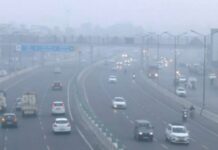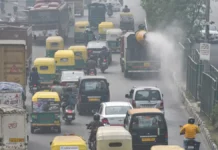NEW DELHI: Scientists have developed a new forecasting system that they say can provide residents of Delhi and other heavily polluted areas of northern India critical information for reducing their exposure to potentially unhealthy air.
The forecasting system, developed by the US-based National Center for Atmospheric Research (NCAR) in collaboration with the Indian Institute of Tropical Meteorology (IITM) in Pune, Maharashtra provides 72-hour forecasts of fine particulate matter, known as PM2.5.
These tiny airborne particles, 2.5 microns or less in diameter, are a major concern because they are small enough to penetrate deep into the lungs or even the bloodstream, potentially causing significant respiratory and cardiac problems, NCAR said in a statement.
The air pollution can become so extreme under typical wintertime meteorological conditions that officials in Delhi have closed schools and restricted traffic on highly polluted days, they said.
“By developing this forecasting system, we are working to provide timely and accurate information to the public about forthcoming episodes of poor air quality,” said NCAR’s Rajesh Kumar, the lead scientist on the project.
“It’s critical to inform people so they can plan in advance to reduce their exposure to air pollutants that can affect their health,” Kumar said in a statement.
The system uses measurements of pollutants, computer modelling, and statistical techniques. It updates the forecast every 24 hours, researchers said.
Preliminary results indicate that it is accurately predicting day-to-day variability in PM2.5, giving officials and residents advance warning of unusually poor air quality.
It does not always capture the precise levels of the pollutant, but Kumar believes they can improve the forecasting system to better predict that.
The technology, which scientists will refine during a two-year research project in India, may eventually be adapted to provide air quality forecasts in other polluted areas in developing countries, as well as in the US.
Delhi ranks among the world’s most polluted cities, according to the World Health Organization (WHO).
It suffers from particularly high levels of PM2.5, a major threat to human health and economic activity throughout much of India and many parts of the developing world.
Fine particulates are emitted from numerous sources, including agricultural fires, motor vehicles, and smokestacks.
On days when atmospheric concentrations of PM2.5 in Delhi soar to many times the level that is considered unhealthy, prolonged exposure to the toxic haze is equivalent to smoking two packs of cigarettes a day, researchers said.
A recent study in Lancet found that fine particulates and other pollutants may have caused more than one million deaths in India in 2017.
Officials have turned to air quality forecasts in the past that drew on computer modelling of basic atmospheric conditions, researchers said.
However, the forecasts were unreliable because they did not include detailed atmospheric measurements or accurate inventories of emissions, nor did they correctly capture some of the atmospheric processes that produce particulates, they said.
The new system attempts to address these limitations by incorporating satellite measurements of particles in the atmosphere and near-real time emissions from major fires associated with crop-residue burning upwind of Delhi, according to the researchers.
It also draws on inventories of emissions from transportation, industry, and other human activities, they said.
This information is fed into an advanced NCAR-based atmospheric chemistry model known as WRF-Chem (the chemistry component of the Weather Research and Forecasting model).
NCAR scientists are developing a specialised statistical system to combine the observations and WRF-Chem output, further improving the accuracy of PM2.5 predictions and enabling scientists to reliably quantify the uncertainties in the forecast.
IITM is also conducting extensive field campaigns and monitoring air quality to better understand processes that influence the formation and movement of particulates in Delhi’s atmosphere.
Kumar and his colleagues are also developing techniques to ensure that the system accurately predicts spikes in PM2.5 related to special events, such as the annual Diwali festival of lights that is celebrated with candles and fireworks.
With air quality a pressing concern across much of the globe, the research team is studying similar forecasting approaches in the US and in additional highly polluted developing countries. PTI






